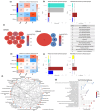Integrative Multi-Omics Profiling of Rhabdomyosarcoma Subtypes Reveals Distinct Molecular Pathways and Biomarker Signatures
- PMID: 40710368
- PMCID: PMC12293488
- DOI: 10.3390/cells14141115
Integrative Multi-Omics Profiling of Rhabdomyosarcoma Subtypes Reveals Distinct Molecular Pathways and Biomarker Signatures
Abstract
Rhabdomyosarcoma (RMS), the most common pediatric soft tissue sarcoma, comprises embryonal (ERMS) and alveolar (ARMS) subtypes with distinct histopathological features, clinical outcomes, and therapeutic responses. To better characterize their molecular distinctions, we performed untargeted plasma proteomics and metabolomics profiling in children with ERMS (n = 18), ARMS (n = 17), and matched healthy controls (n = 18). Differential expression, functional enrichment (GO, KEGG, RaMP-DB), co-expression network analysis (WGCNA/WMCNA), and multi-omics integration (DIABLO, MOFA) revealed distinct molecular signatures for each subtype. ARMS displayed elevated oncogenic and stemness-associated proteins (e.g., cyclin E1, FAP, myotrophin) and metabolites involved in lipid transport, fatty acid metabolism, and polyamine biosynthesis. In contrast, ERMS was enriched in immune-related and myogenic proteins (e.g., myosin-9, SAA2, S100A11) and metabolites linked to glutamate/glycine metabolism and redox homeostasis. Pathway analyses highlighted subtype-specific activation of PI3K-Akt and Hippo signaling in ARMS and immune and coagulation pathways in ERMS. Additionally, the proteomics and metabolomics datasets showed association with clinical parameters, including disease stage, lymph node involvement, and age, demonstrating clear molecular discrimination consistent with clinical observation. Co-expression networks and integrative analyses further reinforced these distinctions, uncovering coordinated protein-metabolite modules. Our findings reveal novel, subtype-specific molecular programs in RMS and propose candidate biomarkers and pathways that may guide precision diagnostics and therapeutic targeting in pediatric sarcomas.
Keywords: alveolar RMS (ARMS); embryonal RMS (ERMS); metabolomics; multi-omics integration; proteomics; rhabdomyosarcoma.
Conflict of interest statement
The authors declare no conflicts of interest.
Figures




Similar articles
-
Alterations of RB1 gene in embryonal and alveolar rhabdomyosarcoma: special reference to utility of pRB immunoreactivity in differential diagnosis of rhabdomyosarcoma subtype.J Cancer Res Clin Oncol. 2008 Oct;134(10):1097-103. doi: 10.1007/s00432-008-0385-3. Epub 2008 Apr 2. J Cancer Res Clin Oncol. 2008. PMID: 18386058 Free PMC article.
-
Transcriptomic Profiling of Relapsed Rhabdomyosarcoma: Pre- and Post-Treatment Tissue Analysis Reveals Molecular Characteristics of Treatment Failure.Pediatr Blood Cancer. 2025 Sep;72(9):e31864. doi: 10.1002/pbc.31864. Epub 2025 Jun 26. Pediatr Blood Cancer. 2025. PMID: 40571676
-
Multi-omics analysis of human plasma reveals reprogramming of tryptophan metabolism associated with inflammation in Mycoplasma pneumoniae pneumonia in children.J Infect. 2025 Jul;91(1):106525. doi: 10.1016/j.jinf.2025.106525. Epub 2025 May 31. J Infect. 2025. PMID: 40456320
-
Fluorine-18-fluorodeoxyglucose (FDG) positron emission tomography (PET) computed tomography (CT) for the detection of bone, lung, and lymph node metastases in rhabdomyosarcoma.Cochrane Database Syst Rev. 2021 Nov 9;11(11):CD012325. doi: 10.1002/14651858.CD012325.pub2. Cochrane Database Syst Rev. 2021. PMID: 34753195 Free PMC article.
-
Multi-omics approaches: transforming the landscape of natural product isolation.Funct Integr Genomics. 2025 Jun 19;25(1):132. doi: 10.1007/s10142-025-01645-7. Funct Integr Genomics. 2025. PMID: 40537580 Review.
References
MeSH terms
Substances
LinkOut - more resources
Full Text Sources
Miscellaneous

